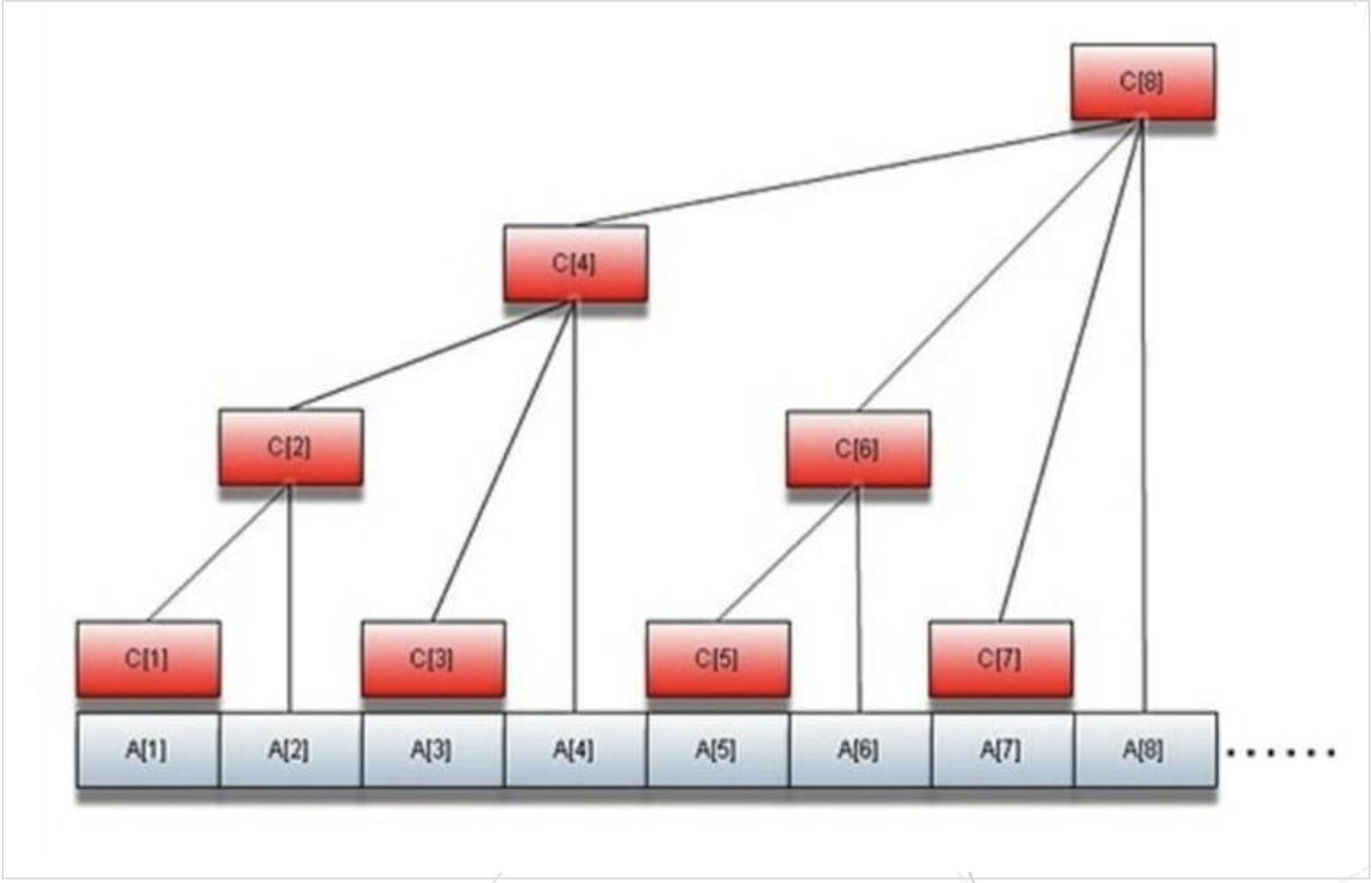LeetCode10 Indexed tree
Binary Indexed Tree(Fenwick tree):
是一个查询和修改复杂度都为log(n)的数据结构。主要用于查询任意两位之间的所有元素之和,但是每次只能修改一个元素的值;经过简单修改可以在log(n)的复杂度下进行范围修改,但是这时只能查询其中一个元素的值(如果加入多个辅助数组则可以实现区间修改与区间查询)
原理:
树状数组是不需要建树的,通过lowbit来建立一个sum数组(此处为c数组)来维护原来的数组
Lowbit讲解:
c[i]=sum(a[j]) i - lowbit(i) + 1 <= j <= i;
这里的 lowbit(i) 表示将i转换成二进制后的最右边的1到最后所形成的十进制的数。
例如 lowbit(6)=lowbit(110)2=(10)2=2
所以 c[6]=a[5]+a[6];
lowbit(4)=lowbit(100)2=(100)2=4
c[4]=a[1]+a[2]+a[3]+a[4]
lowbit[5]=lowbit(101) 2 =(1) 2=1;
c[5]=a[5]
Lowbit公式:
- lowbit(i)=i&(-i);
公式原理:
上面这个公式是非常重要的,就是通过求出一个数的 Lowbit 将这些数据建立成一个树的,父子节点和线段树关系类似,都是通过某种固定的方式建立起来的。而 lowbit 的原理就是利用了计算机里面的反码和补码(这世界本来就是二进制的!)
我们都知道在计算机中数使用二进制存储的,int 是 4 字节,例如我们把5换成二进制。 5=00000000 00000000 00000000 00000101 这同时也是5的原码。 原码:一个正数,按照值大小转换成的二进制数;一个负数按照绝对值大小转换成的二进制数,然后最高位补1,称为原码。
那么-5的原码就是 -5=10000000 00000000 00000000 00000101 ,其中,最高位的1是符号位。 在计算机中储存一个数用的是补码的形式,要了解补码需要先知道什么是反码。 反码:正数的反码与原码相同,负数的反码为对该数的原码除符号位外各位取反 -5的反码就是: 11111111 11111111 11111111 11111010
再说补码:正数的补码与原码相同,负数的补码是这个数的反码+1 -5:11111111 11111111 11111111 11111010+1= 11111111 11111111 11111111 11111011
那么我们利用这个公式 x&(-x) 的意义:
6&(-6):
6: 00000000 00000000 00000000 00000110
-6: 11111111 11111111 11111111 11111010
Ans: 00000000 00000000 00000000 00000010
所以说 lowbit(6) 的结果很明显就是2
节点i的父亲节点为i+lowbit(i) 若需改变a[i],则c[i]、c[i+lowbit(i)]、 c[i+lowbit(i)+lowbit(i+lowbit(i)]……一直加到上限,就是需要改变的c数组中的元素。
若需查询s[i],则 c[i] 、 c[i-lowbit(i)] 、c[i-lowbit(i)-lowbit(i-lowbit(i))] ……就是需要累加的c数组中的元素。 这样我们就让复杂度优化到了 O(logn)
public void change(int index, int val){ while (index <= maxValue){ sum[index] += val; index += index & (- index); } }
public int sum(int index){ int sum = 0; while( index >= 0){ sum += sum[index]; index -= index & (-index); } }
树状数组原理图:

herf: http://xorex.top/2017/05/20/二叉索引树-树状数组-——讲解/
2D Binary Indexed Tree (Fenwick Tree)
Algorithm:
We consider the below example. Suppose we have to find the sum of all numbers inside the highlighted area-
We assume the origin of the matrix at the bottom – O.Then a 2D BIT exploits the fact that-
Sum under the marked area = Sum(OB) - Sum(OD) - Sum(OA) + Sum(OC)


In our program, we use the getSum(x, y) function which finds the sum of the matrix from (0, 0) to (x, y).
Hence the below formula :Sum under the marked area = Sum(OB) - Sum(OD) - Sum(OA) + Sum(OC)
The above formula gets reduced to, Query(x1,y1,x2,y2) = getSum(x2, y2) - getSum(x2, y1-1) - getSum(x1-1, y2) + getSum(x1-1, y1-1) ;
308. Range Sum Query 2D - Mutable
class NumMatrix { int [][] tree; int [][] matrix; int m; int n; public NumMatrix(int[][] matrix) { if(matrix.length == 0 || matrix[0].length == 0) return;// 先判断,再赋值。因为有可能,matrix.length = 0, 那么matrix[0]就会out index boundary。所以上述顺序也不能改变。 m = matrix.length; n = matrix[0].length; tree = new int[m + 1][n + 1];//对应的[m][n]的信息其实是存在[m+1][n+1]中 this.matrix = new int[m][n]; for(int i = 0; i < m; ++i){ for(int j = 0; j < n; ++j){ update(i, j, matrix[i][j]); } } } public void update(int row, int col, int val) { if(m == 0 || n == 0) return; int update = val - matrix[row][col]; matrix[row][col] = val;//必须要新立一个matrix,因为input只是一个variable,需要一个成员变量来保存 for(int i = row + 1; i <= m; i += i & (-i)){ for(int j = col + 1; j <= n; j += j & (-j)){ tree[i][j] += update; } } } public int sumRegion(int row1, int col1, int row2, int col2) { if(m == 0 || n == 0) return 0; return sum(row2 + 1, col2 + 1) + sum(row1, col1) - sum(row1, col2 + 1) - sum(row2 + 1, col1); } public int sum(int row, int col){ int sum = 0; for(int i = row; i > 0; i -= i & (-i)){ for(int j = col; j > 0; j -= j & (-j)){ sum += tree[i][j]; } } return sum; } }
- Time Complexity :
- Both update and sumRegion function takes O(log(MN)) time.
- Building the 2D tree takes O(NM log(NM))
- Answering Q queries takes O(Qlog(NM))
- M = matrix.length N = matrix[0].length



